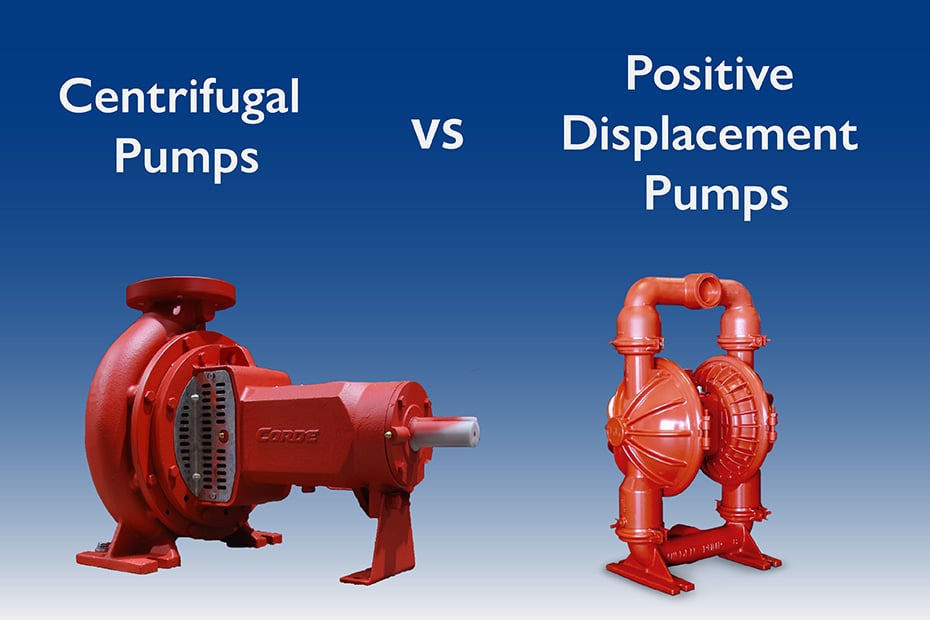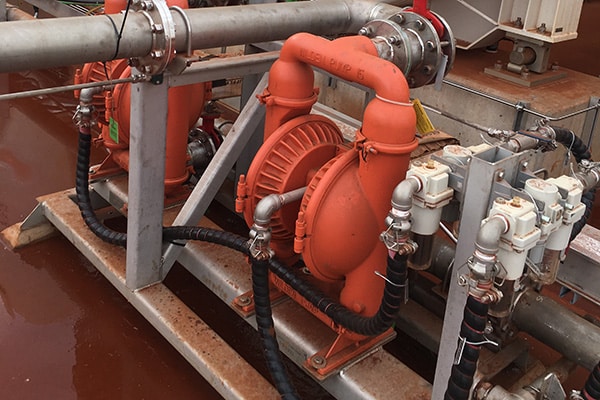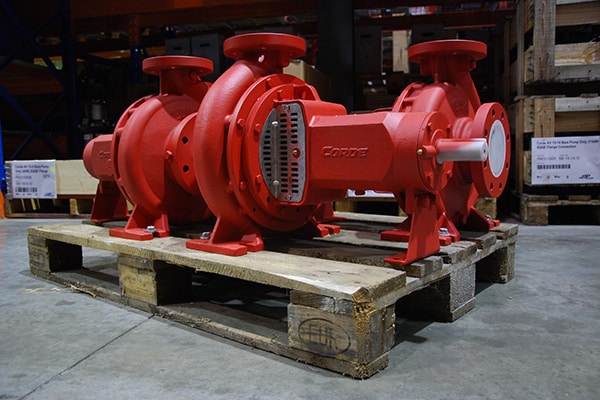
Understanding the differences between centrifugal pumps vs positive displacement pumps is crucial for choosing the right pump for your application. Knowing which pump technology best fits your needs can lead to greater efficiency, lower costs, and improved performance.
In today’s blog, we’ll explore the key differences between centrifugal vs positive displacement pumps, and how to determine the best pump for your needs.
A centrifugal pump works by using a rotating impeller to make the fluid flow. As the impeller spins, it pushes the fluid outward due to centrifugal force. This pressurised fluid then exits through the pump’s discharge outlet, where it can be directed to the desired location.
Centrifugal pumps are ideal for pumping low-viscosity fluids such as water, oils with low thickness, and thin liquids. However, they are generally not effective with thick, viscous fluids or those containing large solids, as these often cause blockages or inefficiency.
A positive displacement pump works by trapping a fixed amount of fluid and then forcing it through the pump’s discharge system. Internal components such as pistons, diaphragms, gears, or screws, mechanically displace the fluid out of the pump.
Unlike centrifugal pumps, which rely on velocity to move fluid, positive displacement pumps provide a constant flow regardless of pressure changes.
This means positive displacement pumps excel at handling high-viscosity fluids and those that contain solids or are abrasive. Examples include thick oils and lubricants, sludges and slurries, syrups, creams, pastes, and fluids with suspended solids.

When choosing between a centrifugal vs positive displacement pump, the decision depends heavily on the specific requirements of your industry. Here’s a guide on which pump is best suited for each industry.
Centrifugal pumps are the standard choice for water supply and distribution systems due to their ability to handle large volumes of low-viscosity fluids like potable water. They are widely used for moving water across long distances, through pipelines, and into municipal or industrial systems.
EXCEPTIONS: In cases handling sludge or water with suspended solids, positive displacement pumps may be used to ensure smooth and consistent flow without clogging.
Centrifugal pumps are best for water treatment plants and wastewater management systems that handle large volumes of low-viscosity fluids. These pumps are excellent for high flow rates, making them perfect for tasks like water circulation, filtration, and sewage management.
EXCEPTIONS: If dealing with sludge, slurries, or fluids with high solid content, a positive displacement pump may be needed to handle the thickness and avoid clogs.
Positive displacement pumps are ideal for moving thick oils through pipelines and delivering consistent flow under high pressure. Especially, when it comes to fluids like crude oil, lubricants, and slurries which are highly viscous and often contain solids.
EXCEPTIONS: For transferring low-viscosity petroleum products like gasoline or light oils, centrifugal pumps might be more efficient, especially for large volumes.
Positive displacement pumps are ideal for this industry due to their ability to handle viscous liquids like syrups, sauces, pastes, and fluids with solids like fruits or pulps. They are also gentle on shear-sensitive products, maintaining the integrity of ingredients during pumping.
EXCEPTIONS: If the application involves low-viscosity fluids, centrifugal pumps may be suitable due to their ability to handle high flow rates efficiently.
Positive displacement pumps are perfect for pumping thick, challenging fluids and maintaining performance even under harsh conditions. Mining operations often deal with abrasive slurries, mud, and fluids with solids which cannot be handled by a centrifugal pump.
EXCEPTIONS: For groundwater pumping or dewatering applications, centrifugal pumps may be used for moving high volumes of low-viscosity water.
Both centrifugal and positive displacement pumps are used in chemical processing, and the choice between the two comes down to fluid viscosity and application.
For low-viscosity fluids like solvents or acids, centrifugal pumps are preferred for their ability to handle high volumes and provide efficient flow. However, for viscous chemicals, gels, or slurries, positive displacement pumps are necessary to maintain steady flow rates and handle the higher resistance caused by fluid thickness.

Centrifugal pumps typically have fewer moving parts compared to positive displacement pumps, which often makes them simpler to maintain. The primary wear points are the bearings and seals, which may need periodic replacement due to wear from friction or fluid contamination.
One issue that affects both types of pumps, is cavitation. In centrifugal pumps it can damage the impeller and other key internal components. For a more in-depth review, see our blog: What is pump cavitation and how to avoid it.
Lastly, centrifugal pumps are highly efficient when operating near their designed flow rates and head pressure. However, their efficiency drops significantly when operating outside of these conditions, especially at lower flow rates.

Positive displacement pumps generally require more maintenance due to their complex internal mechanisms (e.g., gears, pistons, diaphragms). The moving parts are in constant contact with the fluid, leading to wear and tear.
Critical components like valves, seals, and rotors may need regular replacement depending on the fluid properties. For example, when pumping slurries or highly viscous fluids.
In terms of efficiency, positive displacement pumps maintain high efficiency across a wide range of pressures and viscosities. They are also particularly energy-efficient when handling high-viscosity fluids like oils, sludges, or syrups.
Centrifugal pumps have lower upfront cost due to their simpler design and widespread availability. In terms of operating costs, they are energy-efficient in optimal flow & pressure conditions and offer lower maintenance expenses (though cavitation and impeller wear can lead to occasional repairs).
Positive displacement pumps have higher upfront cost due to complex design and specialised components. However, they are extremely energy-efficient when handling high-viscosity fluids or maintaining constant flow rates. Unfortunately, maintenance expenses are higher due to more wear-prone parts and complex internal components.
Although cost is often important, when it comes to choosing between a centrifugal vs positive displacement pump, you should prioritise industry application.

At Allied Pumps, you can find a wide variety of centrifugal and positive displacement pumps to suit every industry application. We have a large stock of some of the most popular brands, and our experienced team can help you select the best pump for your needs.
Specialised Centrifugal Pumps:
Don’t hesitate to contact us for more details about each pump or for help selecting the best one for your needs!

Contact us to learn about how we can help you with your pump needs.
CALL US NOW EMAIL US